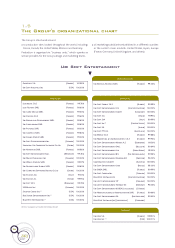Ubisoft 2002 Annual Report Download - page 46
Download and view the complete annual report
Please find page 46 of the 2002 Ubisoft annual report below. You can navigate through the pages in the report by either clicking on the pages listed below, or by using the keyword search tool below to find specific information within the annual report.
2003
46
FINANCIAL
REPORT
k.Cash
Cash consists of the balances of cash and bank accounts.
l.Deferred tax
Deferred taxes are entered in the income statement and the
balance sheet to reflect the difference between financial years
when certain expenditures and revenues are entered into the
consolidated accounts and the financial years when they are
used to calculate results for tax purposes.
Deferred taxes are entered in the income statement and
balance sheet to reflect deficits carried forward in the year
when it seems likely that they will be recovered.
In accordance with the liability method of tax allocation, the
effect of any changes in tax rates on deferred taxes recorded
earlier is entered into the income statement for the financial
year in which the changes in rates become known.
m.Conversion of items expressed in foreign currencies
Conversion into euros of items expressed in foreign currencies
for French companies
Charges and revenue for foreign currency transactions are
entered at their equivalent value on the transaction date.
Assets and liabilities are usually converted at the closing rate,
with any exchange rate conversion differences resulting from
this conversion being recorded in the income statement.
Conversion of the financial statements of foreign subsidiaries
into euros
The conversion of the accounts of foreign subsidiaries
depends on their operating currency.
The conversion of the accounts of a foreign company from
its local currency to its operating currency is carried out in
accordance with the historical rate method. In the historical
rate method, monetary items in the balance sheet are
converted at the closing rate and non-monetary items at the
historical rate. The income statement is converted at the
average annual rate. The conversion rate adjustments are
recorded in the income statement.
The conversion of the accounts of a foreign company from
its operating currency to the currency of the consolidating
company is carried out in accordance with the closing rate
method.This involves converting the assets and liabilities of
foreign subsidiaries at the exchange rate in force at the close
of the financial year, while the income statement is
converted at the average annual rate.Shareholders' equity is
kept at the historical rate. The conversion rate adjustments
are entered in shareholders' equity.
Special case of companies located in countries with a high
inflation rate:
A distinction must be made according to whether the foreign
subsidiary is autonomous or non-autonomous:
When a subsidiary is not autonomous, i.e. when it constitutes
an extension of the foreign activities of the consolidating
subsidiary and when most of its commercial or financial
activities are conducted with the consolidating company, the
conversion of accounts is carried out in accordance with the
general rule.
● When a subsidiary is autonomous,i.e. when it is economically
and financially independent with respect to the consolidating
company or other consolidated companies, the historical rate
method is used to convert into the consolidation currency.
n.Provisions for risks and charges
Provisions for risks and charges are made when risks and
charges which relate to a clearly determined object,but which
are not certain to arise, are made more likely by events which
have occurred or are in progress.
As of March 31, 2003,provisions for risks and charges covered:
●provisions for retirement,
●risks relating to a tax inspection,
●risks relating to the closing of certain subsidiaries with low
levels of activity.
●provisions for lawsuits.
o. Fully diluted earnings per share
This figure is obtained by dividing:
●net earnings before dilution, plus the after-tax amount of any
savings in financial costs resulting from the conversion of the
diluting instruments
●by the average weighted number of ordinary shares in
circulation plus the number of shares that would be
created as a result of the conversion of convertible
instruments into shares and the exercising of rights.
























